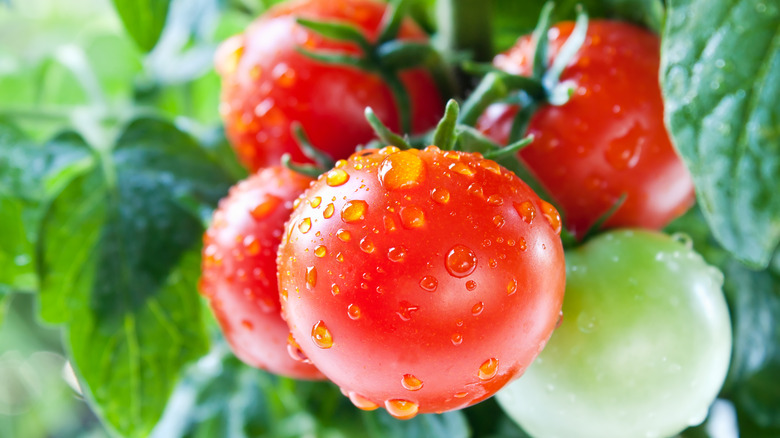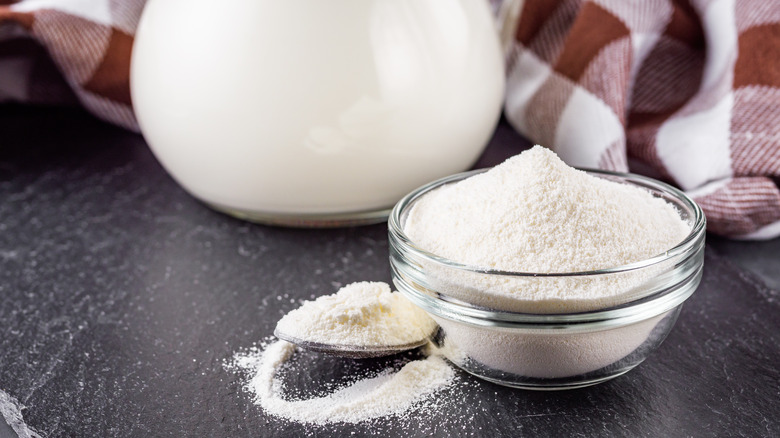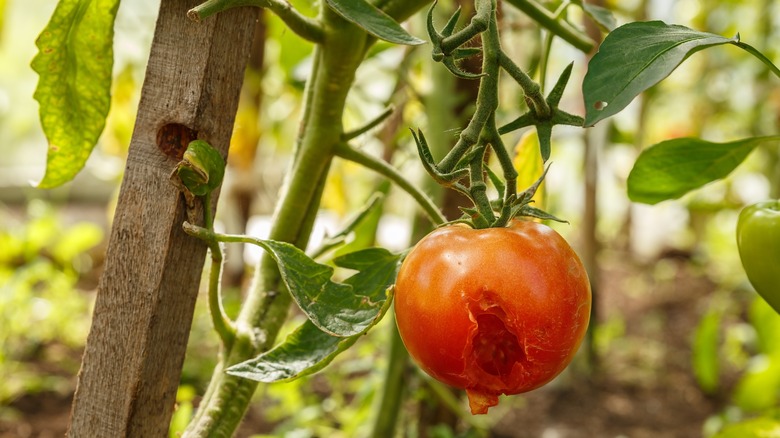Is Milk The Secret Ingredient You Need For Thriving Tomatoes?
Few things are better than a plump, red tomato straight from the vine. Gardeners everywhere are in constant pursuit of this rich reward. While some growing hacks are hotly debated, like the virtues and drawbacks of cracking an egg into tomato plants, others are pretty well regarded by science and experienced gardeners. One of those is using milk products to add calcium, fight fungi, and generally produce all-around amazing tomatoes.
Everyone knows that milk is rich in calcium. Although tomato plants (unlike humans) don't need to strengthen their bones with this all-important mineral, their plant cell walls rely on calcium to keep the plant healthy. When the calcium balance in the soil is off the mark, tomato plants can suffer needlessly. In particular, "Calcium is important to prevent blossom end rot," says House Digest's Master Gardener Tiffany Selvey. Indeed, blossom end rot is an annoying scourge that too many tomato gardeners see, and it is hallmarked by the bottoms of tomatoes turning brown, with spots that are rough and wrinkly in texture. However, there's no need to accept blossom end rot as an unfortunate inevitability, as the careful application of specific milk products can correct the calcium imbalance.
Use these types of milk to add calcium to tomato plants
Dairy milk is the best way to add calcium to tomato plants, per Tiffany Selvey. However, she notes, "It is a very expensive way to fertilize plants." Instead, she suggests powdered milk as a more cost-effective option. Powdered milk is shockingly easy to apply to tomato plants. Before you proceed, however, test your garden's calcium levels with a soil test. You can either buy a professional one to send off to be tested at a lab for a more precise reading, or you can buy an at-home soil analysis kit. If your calcium levels are too low, sprinkle powdered milk at the base of tomato plants and follow up with a good watering so that it soaks into the soil.
Certain types of liquid dairy milk are also acceptable to use, especially if you have any about to go bad. "It is a good way to use expired milk," Selvey says. You might as well get your money's worth, right? That said, don't use whole or skim milk; instead, opt for 2% or 1% milk. Evaporated milk is also acceptable! The key to using liquid dairy products is to make sure it's diluted so that the mixture is roughly half water and half milk product. The mixture can be poured directly into the dirt around the plant or applied to the leaves using a spray bottle. Ideally, this will reset the soil's calcium levels and produce luscious, rot-free tomatoes!
Possible side effects of milk on tomato plants
There are a couple of potential downsides to using milk to fertilize tomato plants. First, it could attract more pests than usual, who can do their own specific damage to those beautiful tomatoes. Milk of any type can also cause the garden to become quite stinky, so that's another thing to consider.
Another problem is that a lot of soil has plenty of calcium all on its own, so don't neglect the testing phase to determine if this step is even necessary because you could do more harm than good. Blossom end rot can be caused by other factors like a lack of bees to pollinate the plants or inadequate water. Consider planting a range of brightly colored flowers to attract pollinators to help your garden thrive and produce better quality tomatoes. Of course, provide plenty of water (1 to 2 inches a week) if Mother Nature doesn't produce it on her own. This is best done via a couple of weekly heavy watering sessions (ideally via soaker hoses or drip lines) rather than a bunch of lighter sessions. But all that depends on the climate where you live and the type of tomatoes planted in your garden.


